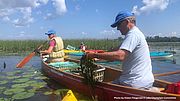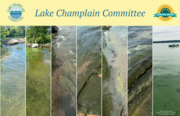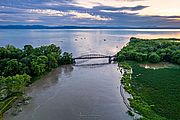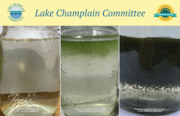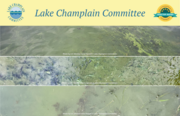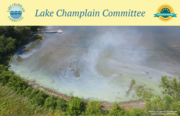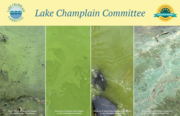Take your gardening skills to the water! Join the Lake Champlain Committee (LCC) and the VT Department of Environmental Conservation for a hands-on activity to remove the invasive water chestnut from the shallow water areas around Sandbar Wildlife Management Area. Read...
News from Selected Month
Blooms took off during week 5 in many areas of Lake Champlain’s St. Albans Bay closing the town beach and impeding recreational use for most of the week. Blooms also showed up at several Burlington sites in Main Lake Central but didn’t persist for as long. August is historically when many locations are more susceptible to blooms and the recent heavy nutrient loading from the July 2023 floods may exacerbate this situation. Read...
The floods of July 2023 brought devastation to so many throughout the Lake Champlain Basin—they inundated homes and businesses, destroyed crops and livelihoods, and washed away roads. Rivers throughout the basin rushed to levels not seen in nearly 100 years, with staggeringly high flow ultimately pouring into Lake Champlain. What did the rivers carry, what does this mean for the lake, and how can we be more resilient in the future? Read...
It has been two weeks since flooding devastated many communities in the Lake Champlain watershed and throughout the state of Vermont. The heavy rains lasted for days and sent rivers and streams over their banks, pouring into homes and businesses and carrying a swill of debris, nutrients, sediment, untreated wastewater, chemicals, and more into Lake Champlain. Read...
There were fewer blooms during week four than during the first two weeks of monitoring but we are not in the heart of bloom season yet. We also likely saw a reprieve in some areas due to the turbidity and dilution factors from the flooding. However, we are bracing ourselves for the after-effects of all the additional nutrient loading which will help feed future blooms. Read...
Far fewer bloom reports were received during Week 3 of the cyanobacteria monitoring season. This is largely attributed to the volatile weather patterns and the increased turbidity from the flooding that affected much of Lake Champlain as well as Vermont inland waterways. The heavy sediment load carried by a high volume of water had a combined effect of limiting light necessary for bloom growth and diluting existing cyanobacteria. However, flooded tributaries also sent high levels of nutrients to Lake Champlain and other waterways. Early estimations are that some tributaries delivered more phosphorus to Lake Champlain during the July 2023 floods than during all of 2022! This will likely fuel blooms later in the season. Read...
Week 2 of cyanobacteria monitoring began with another spate of bloom reports and ended with catastrophic flooding which has devastated communities in the Lake Champlain watershed and throughout the state of Vermont. We hope you are safe, healthy, and dry—and that you’ve made it through the storms (which aren’t over) without damage. While Lake Champlain is below flood stage, it is receiving a heavy load of debris, nutrients, sediment, and a stormwater swill of oil and other pollutants from swollen tributaries, wastewater overflows, and failed septic systems. Read...
Lake Champlain has one particular quality that sets it apart from its Great Lake neighbors. The Lake Champlain Basin has the highest ratio of land to water; in other words, it has the greatest amount of land draining to the smallest area of water. That means that residents of the Lake Champlain Basin .have an opportunity to use land stewardship as a means of water protection. There are many approaches to managing land with water quality in mind depending on what kind of land you’re working with, but one surefire land management strategy for healthy waterways is a stream buffer. Read...
Cyanobacteria Monitoring began the week of June 25 and will run through early fall. Subscribers to our emails will receive weekly updates about conditions monitors are finding on Lake Champlain and at many inland lakes. This week’s report covers conditions from Sunday, June 25 through Saturday, July 1, 2023. If you’d like to learn more about cyanobacteria or join our monitoring team please sign up here. We will hold training sessions on Wednesday July 12 from 9:00 a.m. until Noon and 5:30 to 8:30 p.m. Read...

